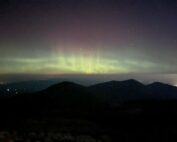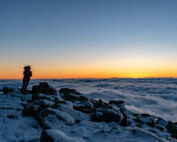Sleet vs. Hail
2015-04-21 15:45:40.000 – Mike Carmon, Co-Director of Summit Operations
Non-meteorologist: “It’s hailing outside.”
Meteorologist: “No, it’s actually sleeting.”
Non-meteorologist: “What’s the difference?”
Meteorologist: “Uhhh…”
This is an exchange I’ve had with friends, family, and peers alike. I always wince a little when hail is mistook for sleet or vice-versa; and I really cringe when it’s assumed there is no difference at all. That’s because both are very distinct precipitation types that form under very different meteorological circumstances. It’s true both sleet and hail are forms of solid precipitation. But that’s about the extent of their commonality.
Sleet is actually a common slang term for “ice pellets.” Ice pellets form due to differences in the temperature profile of the atmosphere. The most common scenario in which a location will experience ice pellets is with the approach of a warm front in the winter months. As warm air approaches behind a front, it rides up and over the relatively cold air in place closer to the surface of the Earth. This creates a temperature inversion, or an increase of temperature with height.
With this setup in place, imagine a hypothetical snowflake falling from high up in the atmosphere. As it hits the warm layer of air incoming behind the warm front, it partially melts. Then, if there is enough cold air still in place at the surface, the partially-melted flake will re-freeze into an ice pellet. This is the process that forms sleet.
Hail, on the other hand, is a much different animal. Hail forms under convective circumstances (thunderstorms), when strong updrafts carry water droplets high into the atmosphere, where they freeze and grow into very large ice structures. The structures grow large enough to the point where their weight can no longer be supported by the updrafts, so they will subsequently plummet towards earth. The hail stones fall so fast that they literally drag the air with them, creating very strong downdrafts.
Updrafts of this strength only develop in convective situations, where the updrafts are strong enough to carry the growing-hail stones up to heights of 20,000-30,000 feet, where they’ll meet with supercooled cloud droplets and continue their growth.
Sleet with a thunderstorm is possible, as we just experienced that on the summit of Mount Washington this weekend. However, the sleet still formed under the same mechanism as described above, not as hailstones. Sleet is more of an indicator of the temperature profile of the environment (warm air above cold air), whereas hail is an indication of extreme instability in the atmosphere.
Mike Carmon, Co-Director of Summit Operations
From Mountains to More Mountains
From Mountains to More Mountains: This Time with Stronger Winds By Alyssa Bélanger On the observation deck in high winds. Hello there! My name is Alyssa Bélanger and I am a fall
From Summit to Sign-Off: My Farewell to the Rockpile
From Summit to Sign-Off: My Farewell to the Rockpile By Amy Cotter Enjoying my last Mount Washington sunset (for now) on September 13, 2025. After two incredible years with the Mount Washington
Trail Report: Seek the Peak Hikes 16 and 17!
Trail Report: Seek the Peak Hikes 16 and 17! By Chris Nichols September 22, 2025 – Summit 16 of 17 A chilly morning turned into a spectacular day on Mount Washington. The thermostat in




